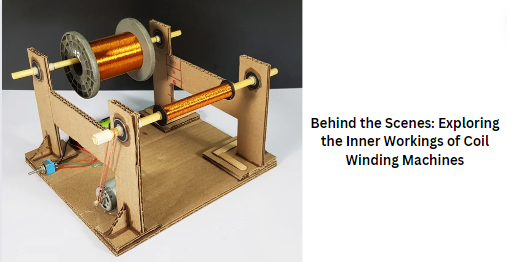
Behind the Scenes: Exploring the Inner Workings of Coil Winding Machines
Coil windings might seem like a simple component, but they play a crucial role in various electrical devices, from transformers to motors.
Yet, how are these intricate coils manufactured with precision and efficiency? The answer lies in the marvel of engineering known as coil winding machines.
In this blog post, we’ll take a deep dive into the inner workings of these machines, uncovering the fascinating process behind the creation of coil windings.
Understanding Coil Windings
Before delving into the complexities of coil winding machines, let’s briefly understand what coil windings are and why they are essential.
In simplest terms, coil windings are wire wound around a core, typically made of materials like iron or ferrite. These windings create electromagnetic fields crucial for the functioning of electrical devices.
Applications of Coil Windings
Coil windings are ubiquitous in electrical engineering and find applications in various industries. They are vital components in transformers, where they facilitate the transfer of electrical energy between circuits.
Motors, generators, inductors, and solenoids are other examples where coil windings are indispensable. The performance and efficiency of these devices often depend on the quality and precision of the coil windings.
The Role of Coil Winding Machines
While hand-winding coil windings is possible, it’s neither efficient nor practical, especially for mass production. Coil winding machines automate the winding process, ensuring consistency, accuracy, and efficiency. These machines come in various types and configurations, each tailored to specific winding requirements.
Types of Coil Winding Machines
1. Manual Coil Winding Machines: These basic machines are operated by hand and are suitable for low-volume production or prototyping. While they offer flexibility, they lack the speed and precision of automated machines.
2. Semi-Automatic Coil Winding Machines: These machines combine manual operation with automated features for increased efficiency. Operators guide the wire while the machine handles winding and tensioning.
3. Fully Automatic Coil Winding Machines: These advanced machines operate autonomously, requiring minimal human intervention. They are capable of high-speed winding with precise control over parameters such as tension, turns, and layering.
Components of Coil Winding Machines
Coil winding machines consist of several key components, each playing a crucial role in the winding process:
1. Wire Feeding Mechanism: This component feeds wire from a spool to the winding area at a controlled speed and tension.
2. Winding Head: The winding head holds the core and rotates it while winding the wire around it. It ensures uniform distribution of windings and precise layering.
3. Tensioning System: Maintains consistent tension on the wire throughout the winding process, preventing slack or breakage.
4. Traverse Mechanism: Controls the lateral movement of the winding head, ensuring even distribution of wire across the core.
5. Control System: Manages various parameters such as speed, tension, and winding pattern, allowing operators to customize the winding process according to specific requirements.
The Winding Process
Now, let’s walk through the typical steps involved in the coil winding process using a fully automatic coil winding machine:
1. Setup: The operator configures the machine settings, including wire diameter, number of turns, winding pattern, and other parameters.
2. Loading: The core, typically made of materials like iron or ferrite, is loaded onto the winding head.
3. Wire Feeding: The machine feeds the wire from the spool to the winding area, maintaining consistent tension.
4. Winding: The winding head rotates, wrapping the wire around the core according to the specified parameters. The traverse mechanism ensures even distribution of windings.
5. Layering: As each layer of winding is completed, the winding head may move vertically or horizontally to start the next layer, depending on the winding pattern.
6. Completion: Once the desired number of turns is reached, the machine stops, removing the completed coil winding from the winding head.
Quality Control
Quality control is paramount in coil winding manufacturing to ensure the reliability and performance of the final product. Coil winding machines are equipped with sensors and monitoring systems to detect abnormalities such as wire breakage, tension variations, or misalignment. Automated inspection processes may also be employed to check parameters such as wire thickness, winding tension, and layer consistency.
Challenges and Innovations
While coil winding machines have greatly improved efficiency and accuracy in manufacturing, they still face challenges such as complex winding geometries, delicate wires, and tight tolerances. However, ongoing advancements in automation, robotics, and machine learning are driving innovation in coil winding technology. Modern machines boast features like adaptive control algorithms, predictive maintenance, and integrated quality assurance systems, pushing the boundaries of what’s possible in coil winding manufacturing.
Conclusion
Coil winding machines are the unsung heroes behind the production of essential components used in countless electrical devices. From transformers to motors, these machines enable the precise and efficient manufacturing of coil windings, ensuring optimal performance and reliability. As technology continues to evolve, so will coil winding machines, shaping the future of electrical engineering and innovation.
In this blog post, we’ve scratched the surface of the intricate world of coil winding machines, shedding light on the intricate process behind the creation of coil windings. The next time you plug in a device or switch on a motor, take a moment to appreciate the intricate coil windings hidden within, silently powering the moder
You May Also Like

What Audio Interface Do I Need To Record My Guitar?
March 2, 2023
A.J. Brown Wallpaper: Celebrating the NFL’s Rising Star
September 14, 2023

